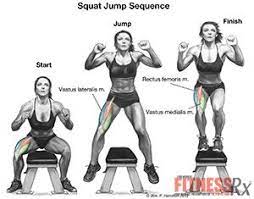Spring is a great time to take stock of how your winter diet and training have progressed. Perhaps your self-examination will reveal that your thighs, calves and buttocks are softer and sagging a bit more than you want. Even if this is the case today, a tighter diet and focused attack on the lower body will turn things around rather quickly. Squat jumps are a great way to start this lower body evolution. They will generate muscle power, improve body balance, firm the thighs, calves and buttocks, and burn calories in the process. It is also a great exercise if you can’t make it to the gym, because you can do squat jumps even if there is no gym in sight.
Muscle Structure and Function
The squat jump involves many thigh, calf and hip muscles, but only the major ones will be discussed here. The quadriceps femoris muscle group consists of four thigh muscles.1 The vastus lateralis muscle covers the lateral part of the femur bone of the thigh. The vastus medialis muscle is anchored to the medial part of the femur. The vastus intermedius muscle is attached to the central, anterior part of the femur. The muscle fibers from these three vasti muscles attach to the quadriceps tendon. The rectus femoris begins on the hipbones at the iliac crest and above the hip joint and not on the femur.2 Its fibers extend to the patellar tendon along with the three vastus muscles to attach to the patella (knee cap). This tendon continues from the patella to the tibia bone of the lower leg as the patellar ligament. Together, the three vasti and the rectus femoris extend the leg at the knee.
The gluteus maximus is the major muscle of the buttocks.1 It extends the thigh when you are jumping upwards from the squat position. The fibers of the gluteus medius muscle run between the ileum bone of the hip and the posterior part of the femur bone of the thigh. It abducts the femur at the hip joint by moving the femur laterally, away from the midline of the body. The gluteus medius maintains body balance during the takeoff and landing of squat jumps.
Together, the long head of the biceps femoris, semimembranosus and semitendinosus muscles are the hamstring muscles that reside on the posterior thigh. These muscles attach to the posterior sides of hip and pelvic bones.1 They extend down the posterior side of the femur bone to attach either on the medial side of the tibia bone of the leg (semitendinosus), the medial side of the superior part of the tibia bone (semimembranosus) or the lateral side of the tibia bone just below the knee (biceps femoris). Together, these muscles flex the knee. However, when the foot is on the ground, the hamstrings extend the hip joint, and therefore these muscles are very active during the upwards leap in jump squats.
Squat Jumps
You should stretch your quadriceps and hamstrings and do a couple minutes of light stationary cycling before beginning this exercise.3 This is important because squat jumps are rather explosive as you thrust upwards from the squat position, so the muscles and joints should first be warmed up appropriately. In addition, your shoes should have a good rubber sole so you won’t slip on the bench.
1. If you have not done these before, start with a low bench that is about 12 inches high.
2. Straddle the bench so that one foot is on either side of it. Your feet should be about shoulder-width apart.
3. Squat down until your knees are flexed to an angle of about 90 degrees. You may wish to raise your arms in front of you to near shoulder level to improve your balance during the jumps.
4. Explosively spring upwards. Bring both feet closer together as you jump so that both feet simultaneously land on top of the bench. Bend your knees to a 90-degree angle and squat when your feet hit the top of the bench. The squat on the bench will increase the work for your thighs and buttocks and it will also absorb the jarring forces that are generated during the jump.
5. Once you are on the bench, thrust upwards from the squat position and jump off the bench. Widen your stance so that both feet hit the floor simultaneously.
6. Immediately squat as your feet hit the floor. This will both absorb the jump downward and also prepare you for the next jump upwards.
7. Continue for a minimum of 15 repetitions but work up to 25. Rest about a minute, and then repeat the set. You can work up to 3 sets. Once you have mastered this, select a higher bench (e.g., 18 inches) and gradually work up to a bench that is 24 inches in height. Don’t worry, you will master the exercise quickly4 and find yourself looking for higher benches very soon.
The relative degree of muscle activity differs among the quadriceps muscles during the jump. The tension in the vasti muscles diminishes as you approach the top portion of the lift (with the knees straightened). Conversely, the rectus femoris is less active at the bottom but becomes more activated when the hip and knee are being extended. Since the gluteus maximus muscle and hamstring muscles are strong extensors of the hip, they are very active during the jump upwards.
This is a really intensive exercise. The muscles of your lower body will be stretched under your bodyweight as you jump off the bench during each repetition,5 which means your muscles can become sore from this exercise. When done correctly, the squat jump can be a great complement to other weight training or cardio. Alternatively, squat jumps can work independently to effectively firm your lower body, burn a lot of calories and give you greater jumping ability6 or just bring a spring to your step.
References:
1. Moore, KL and AF Dalley. Clinically Oriented Anatomy. Fourth edition. Baltimore, Lippincott Williams & Williams, 1999; 531-546.
2. Waligora AC, Johanson NA, Hirsch BE. Clinical anatomy of the quadriceps femoris and extensor apparatus of the knee. Clin Orthop Relat Res 2009; 467: 3297-3306.
3. Pacheco L, Balius R, Aliste L et al. The acute effects of different stretching exercises on jump performance. J Strength Cond Res 2011;25:2991-2998.
4. Randell AD, Cronin JB, Keogh JW et al. Reliability of performance velocity for jump squats under feedback and nonfeedback conditions. J Strength Cond Res 2011;25:3514-3518.
5. Foure A, Nordez A, Cornu C. Effects of plyometric training on passive stiffness of gastrocnemii muscles and Achilles tendon. Eur J Appl Physiol 2011; in press.
6. Ziv, G , Lidor, R 2009. Vertical jump in female and male basketball players-A review of observational and experimental studies. J Sci Med Sport 2010;13, 332-339, 2010.
The post Get a Firm Butt and Thighs With Squat Jumps first appeared on FitnessRX for Women.




